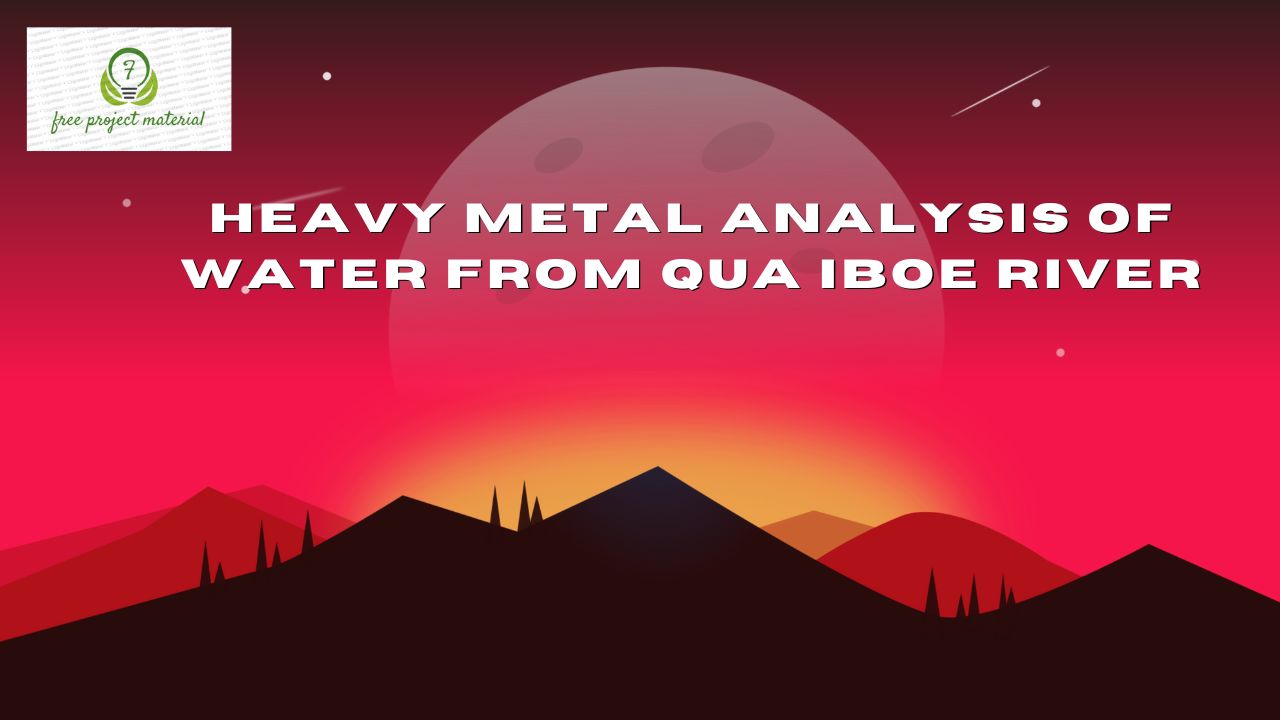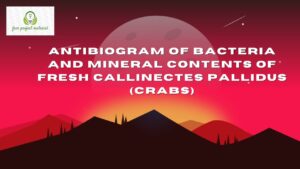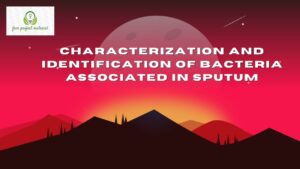ABSTRACT
This study was aimed at estimating the heavy metal composition of water form Qua Iboe River. The sample was collected from the study area and standard analytical method were used in carrying out the analysis. The result of the study revealed the following; Cd (1.2155±0.002 mg/L), Pb (0.9115±0.002 mg/L), Cr (1.3335±0.002 mg/L), Ni (1.0565±0.002 mg/L). The values were higher than the WHO permissible limit, this therefore indicate an health risk to the population which implies that there is quick and urgent need for intervention to limit the deteriorating status of the river. Therefore it is recommended that government should place regular monitoring agencies in order to ensure the safety of the river and introduction of heavy metal pollutant into the food chain.
TABLE OF CONTENTS
Title Page – – – – – – – – – i
Certification – – – – – – – – ii
Dedication – – – – – – – – – iii
Acknowledgments – – – – – – – iv
Abstract – – – – – – – – – v
Table of Contents – – – – – – – vi-vii
CHAPTER ONE: INTRODUCTION – – – – 1-2
- Background of the Study – – – – – – 3-4
- Aim and Objectives of the Study – – – – 4
- Scope and Limitation of the Study – – – – 4
- Definition of Terms – – – – – – 4-5
CHAPTER TWO: LITERATURE REVIEW
2.0 Qua Iboe River – – – – – – – 6
2.1 Sources of Heavy Metals in the Qua Iboe River – – 6-7
2.1.1 Waste Water – – – – – – – 7
2.1.2 Air Borne Source – – – – – – – 7
2.1.3 Metal and Milling Processes – – – – – 8
2.1.4 Pesticide – – – – – – – – 8-9
2.2 Remediation of Heavy Metal in River – – – – 9
2.3 Heavy Metal and Their Toxicity Effect – – – 9-10
2.4 Heavy Metals – – – – – – – 10
2.4.1 Zinc – – – – – – – – – 10-11
2.4.2 Iron – – – – – – – – – 11
2.4.3 Lead – – – – – – – – – 12
2.4.4 Copper – – – – – – – – 12-13
2.4.5 Nickel – – – – – – – – 13
CHAPTER THREE: MATERIALS AND METHODS
3.1 Materials – – – – – – – – 14
3.1.1 Chemical used – – – – – – – 14
3.1.2 Equipment Used – – – – – – – 14
3.2 Study Area – – – – – – – – 14-16
3.3 Method – – – – – – – – 17
3.3.1 Sample Collection and Preparation – – – – 17
3.3.2 Digestion of the Sample – – – – – – 17
3.3.3 Determination of Heavy Metals Using Atomic Absorption Spectrophotometer (AAS) – – – – – – 17-18
CHAPTER FOUR: RESULTS AND DISCUSSION
4.1 Results – – – – – – – – 19
4.2 Discussion – – – – – – – – 20-22
CHAPTER FIVE: CONCLUSION AND RECOMMENDATION
5.1 Conclusion – – – – – – – – 23
5.2 Recommendation – – – – – – – 23
References
CHAPTER ONE
1.0 INTRODUCTION
Increasing population growth, with urbanization and industrialization at the coastal regions in recent decade have regularly introduced toxic pollutants especially metal into the aquatic ecosystem (Montawo and Greary, 2014). Metals are important environmental contaminants due to their toxicity, persistence and their tendency to accumulate in aquatic organisms. They are transported as dissolved species in water or as an integral part of suspended sediments (Atanuegwa, 2005).
Modern technologies have brought about rapid increase in world population, industrialization and urbanization. These have in turn caused a corresponding increase in the volume of domestic and industrial wastes generated, but the improper management of these wastes results in environmental pollution problem. This problem affects both the developed and underdeveloped nations though to different extents, hence it becomes pertinent that adequate focus be placed on its control to avoid a disaster which may be similar to the incidence of methyl mercury poisoning which occurred in Japan.
Sastry and Tyagi (2011), pointed out that water pollution by heavy metals has become a health hazard in recent years. Similarly, Warren (2018), noted that man’s activities have increased the quantity and distribution of heavy metal in the atmosphere, on land and river, lakes and seas. The extents of this widespread of heavy metals contamination has caused great concern about its possible effects on plants, animal and human beings.
Some authors have indicated certain process that could be affected by heavy metal levels in fish to include physiological balance and respiratory processes (Hermmandez and Diaz, 2010).
Although aquatic environment naturally contains little amount of heavy metal in a highly industrialized area such as the one under study, the level of these metals could be unexpectedly high. Ibeno, where a lot of down streams industries are located including Mobil producing Nigeria Unlimited (MPNU), which involves in petroleum exploitation and production activities in the area can contaminate or pollute the environment.
1.1 Background of the Study
Heavy metals have a large effect on the environment and cause many health risks for humans. When heavy metal accumulate to toxic level, they can cause illness in human (Sastry and Tyagi, 2011). Heavy metals were becoming more critical and often accumulate through tropic levels causing deleterious biological effects (Olouosegun, K. M, 2015).
There are heavy metals are from anthropogenic activities like petroleum exploitation and production activities and also from the indiscriminate use of heavy metal containing agricultural fertilizer and pesticide. Several of the metal such as Cu, Fe, Zn and Ni are essential micro-nutrient for life processes in living organisms.
However, heavy metal like lead, do not have any physiological activity but have been proven to be determined when their concentration exceeds a certain limit.
These heavy metal are linked to deadly diseases such as edema of eyelids, tumor, congestion of nasal mucor membrane and pharynx, thus determining or monitoring the concentration of these heavy metal is imperative for safety assessment of the environment and human health in particular (Sastry and Tyagi, 2011).
1.2 Aim and Objectives of the Study
- To analyze the heavy metal present in Qua Iboe River.
- To compare the result obtained with the WHO permissible standard
- To ascertain whether it imposes threat the organisms living there
- Scope and Limitation of the Study
The design of this research work is to investigate and analyze some heavy metal present in Qua Iboe river.
Due to time, financial constraint, this project work, is limited to estimate the level of some heavy metal in Qua Iboe river (Cu, Fe, Zn, Pb and Ni).
- Definition of Term
- Heavy metal: The term heavy metal refers to any metallic chemical element that has relatively high density and is toxic or poisonous at low concentration e.g of heavy metal include lead (Pb), Copper (Cu), Nickel, (Ni), Iron (Fe).
- Waste water: waste water is used water from any combination of domestic, industrial, commercial or agricultural activities.
- Bioremediation: This is a waste management technique that involves the use of organisms to remove neutralize pollutants from a contaminated site.
- Digestion: This is defined as the breaking down of a large insoluble food molecule into smaller water – soluble food molecules.



